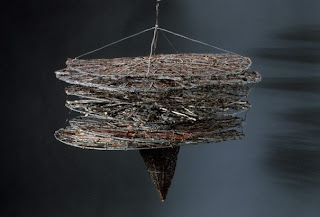Translate
Friday, June 28, 2013
Sunday, June 23, 2013
Healing Machines
The need that we have to make environments intrigues me. Whether it be the work of one person, with their own rules, or the work of many people who are following a plan.
"In the early 1960s, Blagdon built a two-part shed behind his house. The small entry served as his workshop and the larger space behind became an increasingly dense environment filled with his creations. He illuminated the site with strings of Christmas tree lights and hand-painted light bulbs in coffee can fixtures attached to the floor. Inspired in part by having watched his parents die of cancer, Blagdon worked for nearly thirty years on sculptures and paintings he described as Healing Machines. He didn’t consider himself an artist. Instead, he was fascinated by electricity and what he saw as its potential for healing at a time when “electropathy” was widely sought as a form of alternative healing. He believed that through the complex and diverse materials in the shed he could channel the powers of the earth, with the potential to cure various illnesses." - from Emory Blagdon, Healing Machines by Mark Karpel. Source is Spaces. Link here.
"In the early 1960s, Blagdon built a two-part shed behind his house. The small entry served as his workshop and the larger space behind became an increasingly dense environment filled with his creations. He illuminated the site with strings of Christmas tree lights and hand-painted light bulbs in coffee can fixtures attached to the floor. Inspired in part by having watched his parents die of cancer, Blagdon worked for nearly thirty years on sculptures and paintings he described as Healing Machines. He didn’t consider himself an artist. Instead, he was fascinated by electricity and what he saw as its potential for healing at a time when “electropathy” was widely sought as a form of alternative healing. He believed that through the complex and diverse materials in the shed he could channel the powers of the earth, with the potential to cure various illnesses." - from Emory Blagdon, Healing Machines by Mark Karpel. Source is Spaces. Link here.
Ritual and Site
Why the need for site and object?
Objects serve as symbols for stories – stories are the belief system –
objects acknowledge the belief system. Is
it the person/people who formulate the belief system that use site and objects
as control? Or is it our human sensual
need for touch and seeing that that require we have something to hold,
something to look at, a place to be?
Conclusion – I am interested in both aspects – how/why we make our own
significant moments and how/why we buy into those that are set up for us. Also, our need to mark space and time.
A bit of notes from looking around on-line:
People need rituals to mark passages of life and
death.
People need to go somewhere and do something to
mark a loss or celebrate the new.
Objects (souvenirs to be kept in remembrance of
event - need tangible to remember - later photography becomes object) or
objects used to perform ritual. Space, gathering site needed to mourn or
celebrate. Marking the passage of time. Recognize emotion.
Gather together or alone.
Rituals mark the passage of time. Birthdays,
anniversaries.
Leaving coins on a grave - originates from Greek
Mythology, paying ones way to a resting place in the under world Hades, place
coin in mouth, no coin and you were left to wander and haunt in the upper
world.
Coins then moved to be placed on eyes, then feet
and then grave.
Burial customs of Romans:
-The soul thought to need provisions in afterlife,
ground above tomb a garden so spirit may wander about and enjoy.
-Cenotaph - an empty tomb for someone who died at
sea, the need to mark a space, the need for a site and the tangible.
Inhumation begins Paleolithic era. Practical or esoteric - it is
unclear. Later peoples believed humans formed out of the earth, so
possible giving back to earth was significant.
Interesting bits of info the above book. Read for free on google. Link here.
Subscribe to:
Posts (Atom)






















.JPG)